Horse
 From Nwe
From Nwe |
?
Domestic Horse |
||||||||||||||
|---|---|---|---|---|---|---|---|---|---|---|---|---|---|---|
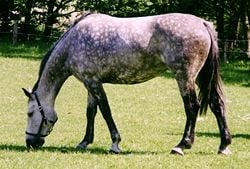 |
||||||||||||||
| Scientific classification | ||||||||||||||
|
||||||||||||||
| Binomial name | ||||||||||||||
| ''Equus caballus Linnaeus, 1861 |
The horse or domestic horse (Equus caballus) is a sizable ungulate ("hoofed") mammal of the family Equidae and the genus Equus. Among the 10 living members of the Equus genus are zebras, donkeys, Przewalski's Horse (a rare Asian species), and hemionids (Onager or Equus hemionus). The donkey (Equus asinus), also known as the burro or domestic ass, like the domestic horse, has many breeds. Przewalski's Horse (Equus ferus przewalskii) and the domestic horse are the only equids that can cross-breed and produce fertile offspring.
Horses, one of the most historically vital domesticated animals to humans, have played a central role in the lives of people for tens of thousands of years. No other animal, domestic or wild, has had so great an impact on the history of civilization as has the horse. The horse was an integral element in warfare and conquest, in transportation and travel, and in art and sport. Its beauty and power are legendary. Since ancient times, the horse has been depicted and revered as the noble bearer of heroes, champions, and gods.
In its design, form, and function, the horse is superbly suited as a purely riding animal. Its spine is fixed and rigid and well devised to bear weight. Its stature is tall, a feature that lends any rider a towering advantage in hunting, sport, and warfare. The horse's legs are long, slender, graceful, and, above all, swift. The speed and ability to cover ground has made horses invaluable to people, and remains so today.
Horses are highly social and intelligent herd animals. They fail to thrive in isolation. Their intrinsic nature is to seek a relationship, which offers mutual benefit, ensuring kinship and protection. Humans have long exploited this social character to their advantage. Through domestication the horse's instinct to herd with other horses has become one to "herd" with or embrace people, and the resulting "willingness to please" makes horses valuable to humanity and heroic figures in movies and literature.
Wild animals, whose ancestors have never undergone domestication, are distinct from feral animals, who had domesticated ancestors but now live in the wild. Isolated feral populations of horses are often named for their geographic location. Several populations of feral horses exist, including those in the western United States and Canada, often called mustangs.
Evolution
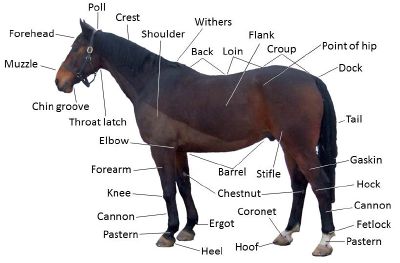
All equids of the family Equidae date back approximately 54 million years to the Eocene period in what is now North America. Horses and other equids are odd-toed ungulates of the order Perissodactyla, a relatively ancient group of browsing and grazing animals that first appeared in the fossil record less than 10 million years after the dinosaurs became extinct at the about 65 mya. Perissodactyls were the dominant group of large terrestrial browsing animals until the Miocene (about 20 million years ago), when even-toed ungulates, with stomachs better adapted to grass digestion, began to out-compete them. Twelve families of odd-toed ungulates have been identified through fossil records, but today only three families survive: horses and their closest living relatives the tapirs and rhinoceroses.
One of the first true horse species was the tiny Hyracotherium, also known as Eohippus. It lived in the Northern Hemisphere (in Asia, Europe, and North America) during the Eocene, between 60 and 45 million years ago. The first fossils of this tiny horse were found in England in 1841 by the famous paleontologist Richard Owen. He did not have a full specimen and called it Hyracotherium, meaning "mole beast." When a full specimen was discovered later, it was given the more fitting name Eohippus, or "dawn horse." It was not realized until later that the two finds were the same species, and the first published name has priority as the official name. It should be noted that some scientists remain unconvinced that Hyracotherium had any connection with horses
Equine evolution has been characterized by a reduction in the number of toes, from 5 per foot, to 3 per foot, to only 1 toe per foot. The primitive Hyracotherium had 4 hoofed toes on the front feet and 3 hoofed toes on each hind foot. In the course of about 5 million years, Orohippus appeared. The vestiges of the first and second toes were not present, but the addition of a new "grinding" tooth was significant in that it signaled a transition to improved capacity for browsing on tougher plant material, which would allow grazing not just on leafy plants but also on plains grasses. The horses thereby could transition from being primarily leaf-eating forest-dwellers to being grass-eating inhabitants of the Great Plains.
The genus Equus, to which all living equids belong, evolved a few million years ago.
Domestication and brief history
Horses come in various sizes and shapes. The draft breeds can top 20 hands (80 inches or about 2 meters) while the smallest miniature horses can stand as low as 5.2 hands (22 inches or about 0.56 meters). The Patagonian Fallabella, usually considered the smallest horse in the world, compares in size to a German shepherd dog.
Domestication may have occurred as early as 4500 B.C.E., although there is speculation that horses were extensively utilized by humans in Babylon, Assyria, Egypt, and Eurasia as early as 5000 B.C.E. Other early evidence for domestication dates from central Asia to approximately 4000 B.C.E.
Competing theories exist as to the time and place of initial domestication. One school, the "Four Foundations" school, suggests that the modern horse evolved from two types of early domesticated pony and two types of early domesticated horse and that the differences between these types account for the differences in types of the modern breeds. A second school, the "Single Foundation" school, holds that only one breed of horse underwent domestication, and it diverged in form after domestication through human selective breeding (or in the case of feral horses, through ecological pressures). The evaluation of DNA and mitochondrial DNA is now being utilized to help in understanding better the family trees of horses.
Until the middle of the twentieth century, the horse was employed primarily in warfare and in lesser numbers for domestic transportation. Conquerors maintained countless numbers of horses in order to traverse vast tracts of land and territory. It was because of the swiftness of the horse that the armies of the Huns, Alexander the Great, the Romans, the Ottomans, Napoleon, and so many others were able to vanquish foes and rule over empires. Soldiers today still refer to the groups of machines that have replaced horses on the battlefield as "cavalry" units, and sometimes preserve traditional horse-oriented names for military units.
Over time, especially within the last three hundred to four hundred years, equine breeds have been developed to fulfill specialized pursuits. Although still used for practical work in parts of the world, in general, horses today are used mainly for competitive sport and pleasure. Equine endeavor may be arranged into three main categories: horse racing, horse showing, and pleasure horses.
Horse racing is considered the world's most popular spectator sport historically. Racing with horses pre-dates recorded history. Humankind raced horse-drawn chariots in early Mesopotamia, in the original Olympic games in Ancient Greece, and in the great Roman circus. These contests were often brutal as teams of fierce stallions were galloped by ruthless warriors, the latter who would commit atrocities to win at any cost. Today, we count flat racing (on tracks or on turf), steeplechasing (distance horse race with diverse fence and ditch obstacles), and harness racing as the three main forms of competitive racing.
Horse showing or horse sport, as currently known, is generally defined as any activity involving horses in a competition other than racing. Sporthorses are equines involved in the so-called English disciplines, such as dressage, show jumping, three-day eventing, endurance riding, driving, polo, fox hunting, and their related activities. Horse shows also include the Western disciplines; these originated in the western United States and include reining, rodeo, cow horses, cutting, and western pleasure, among others.
Horse behavior
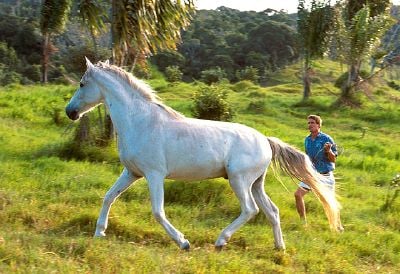
Horses are prey animals with a flight or fight instinct. Their first response to threat is to flee. However, they are known to defend themselves when cornered and the fight instinct is also triggered when offspring, such as a foal (young horse), is threatened. Through selective breeding, some horses have been made more docile, but most sport horse breeds are based on the principle of preserving the natural instincts that existed in horses that were taken from wild herds hundreds of years ago.
Horses are highly social herd animals.
In the wild, horse societies are matriarchal. At the center of the herd is the alpha or dominant mare (female horse). Herds are made up of mares, foals, and immature horses of both sexes. A herd of twenty mares can produce twenty foals in one year.
The center of the herd is the safest because it is further away from predators than any other part. The edge of the herd is where the lowest on the social order are found. Punishment is delivered in the form of expulsion from the herd on a temporary or even permanent basis.
The dominant stallion (male horse) lives on the periphery of the herd, and it is his role to stand as the herd sire to produce offspring, as well as to repel challenges for dominance from other stallions who might become a successor. The dominant stallion lives in the most dangerous and tenuous position in the equine world. Living on the periphery, he is exposed to predators and other bachelors who will fight him for the role of dominant stallion. In stark contrast to the mythology of the stallion and his (ownership implied) harem, he has no value to the herd itself beyond reproduction. In a sense, he is dispensable since he is easily replaced. The male dominance hierarchy ensures an immediate replacement by a strong and healthy successor at any time.
When colts (male foals) become mature, they are cast out by the dominant stallion and are no longer welcome in the herd. For what may be years, they form small bachelor herds and roam until the time when they may battle for the privilege of becoming the next dominant stallion.
As with many animals that live in large groups, establishment of a stable hierarchy or pecking order is important to smooth group functioning. Contention for dominance can be risky since one well placed kick to a leg could cripple another horse to such an extent that it would be defenseless, exposed, and possibly unable to get to water. Survival dictates that the herd members ultimately cooperate and stick together. The alpha or dominant mare exercises control over herd members to moderate aggressive behavior.
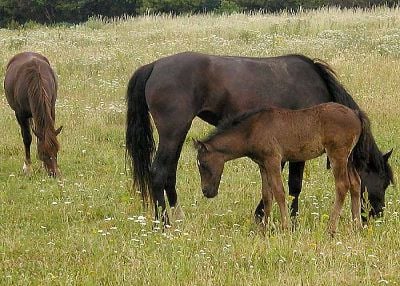
Horse behavior and humans
The ability of humans to work in cooperation with horses is based on the strong social bonds that horses have with each other. Horses resist being separated from the herd, because to be alone is to be exposed to predators on all sides. Horse training principles are based upon having the horse accept a person as the dominant herd member, not through force, but by virtue of ability and confidence. In pastures, it is the rule that horses tend to gravitate around the most mature and confident members. Those attributes are highly valued because they point the way to survival. A horse that is afraid more than necessary will expend energy needlessly and may not be able to escape when the threat is real.
Providing that they do not regard humans as they would regard predators, horses will treat humans in much the same way that they treat other horses. As a result, horses will be willing to associate with humans in a cooperative way, but they may also challenge humans for dominance. Humans who train horses teach that aggression towards humans will meet with sure but measured and appropriate retaliation. Once horses have been deterred from kicking and biting humans to secure dominance over them, a cooperative relationship can be maintained.
However, humans sometimes abuse horses. Ordinarily, horses tolerate some human misbehavior, but when the balance tips, a horse can become a deadly enemy. Abused horses can be very dangerous because they cease treating humans as members of their group; instead humans are treated as predators. Horse bites can sever limbs, and horse kicks can be deadly. Rehabilitation of a horse that has been forced to aggressively defend itself against humans is very difficult and not without real risk.
Equestrian Vocabulary
Horses and humans have lived and worked together for thousands of years; an extensive specialized vocabulary has arisen to describe virtually everything to do with equines.
Size

The English-speaking world measures the height of horses in hands. One hand is defined as a measure of 4 inches (101.6 mm). Horse height is measured at the highest point of an animal's withers—the highest point on an animal's back, on the ridge between its shoulder blades. By convention, 15.2 hh means 15 hands, 2 inches (1.57 m) in height.
Size alone marks the difference between horses and ponies. The threshold is 14.2 hh (1.47 m) and under for an adult pony. Above that threshold, the equine is a horse. Ponies are further divided into sizes according to the height at the withers. Small ponies are 12.2hh and under. Medium ponies are over 12.2hh, but do not exceed 13.2hh. Large ponies are over 13.2hh but do not exceed 14.2hh.
General Terminology
The following are some common terms related to horses.
- Colt - an un-nuetered male horse from birth till the age of 4.
- Filly - female horse from birth till the age of 4.
- Foal - infant horse of either sex.
- Mare - adult female horse.
- Stallion - adult, male horse that is capable of producing offspring.
- Gelding - a castrated male horse of any age.
- Horse - adult equine of either sex over 14.2 hh.
- Weanling - a young horse that has just been weaned from their mother (usually 6 months or a little older).
- Yearling - male or female horse one to two years old.
- Purebred - any horse whose recent ancestors are of the same breed.
- Draft horse - heavy, muscular horse used mainly for pulling and driving.
- Light Horse - light to medium horses used mainly for riding and fine harness.
- Pony - equine 14.2 hh or less.
- Green - a term used to describe an inexperienced or untrained horse.
Gaits
All horses move naturally with four basic gaits (manner of moving). These are referred to as the walk, the trot/jog, the canter/lope, and the gallop.
The walk is a "four-beat" lateral gait in which a horse must have three feet on the ground and only one foot in the air at any time. The walking horse will lift first a hind leg, then the foreleg on the same side, then the remaining hind leg, then the foreleg on the same side.
The trot or jog ("trot" for English riding, "jog" for Western riding) is a "two beat" diagonal gait in which a foreleg and opposite hind leg (often called "diagonals") touch the ground at the same time. In this gait, each leg bears weight separately. There are two types of trots a rider can perform; these are called posting trot, in which the rider stands up slightly in the saddle each time the animal's outside front leg goes forward, and sitting trot, in which the rider sits in the saddle and matches the horse's movement.
The canter or lope ("canter" for English riding, "lope" for Western riding), is a restrained form of a gallop. It is a three-beat gait in which a foreleg and opposite hind leg strike the ground together, while the other two legs strike separately. A cantering horse will first stride off with the outside hind leg, then the inside hind and outside fore together, then the inside front leg, and finally a period of suspension in which all four legs are off the ground. The rhythm should be 1-2-3, 1-2-3, etc.
The gallop is another four-beat gait which follows a similar progression to the canter, except the two paired legs land separately, the hind leg landing slightly before the foreleg. It is the fastest of all gaits; a fit, racing thoroughbred can course at a gallop over forty miles an hour.
Horse colors

Horses exhibit a diverse array of coat colors and distinctive markings, and a specialized vocabulary has evolved to describe them. In fact, one will often refer to a horse in the field by his or her coat color rather than by breed or by gender. Some of the common coat colors are:
- Bay - From light brown to very dark brown with black points and intermingling red or blue hairs in some cases. (Points refer to the mane, tail, muzzle, lower legs, and tips of the ears.) The four bay types are dark bay (mixed blue hair), blood bay (mixed red hair), light bay, and just bay.
- Black - For a horse to be considered black it must be completely black with no brown at all, only white markings. Ordinary black horses will fade to a rusty brownish color if the horse is exposed to sunlight on a regular basis. Such horses would be considered brown as soon as the black coat gets any brown.
- Chestnut - A color from golden-reddish to a liver color with no black.
- Dun - Yellowish brown with a dorsal stripe along the back and occasionally zebra striping on the legs.
- Gray - A horse with black skin and clear hairs. Gray horses can be born any color, and eventually most will turn gray or white with age. If you would define the horse as white, it is still gray unless it is albino. Some gray horses that are very light require sunscreen for protection.
- Grulla - A horse that is often a grayish/silver colored horse with dark dun factors.
- Pinto or Paint - a multi-colored horse with large patches of brown, white, and/or black and white. Piebald is black and white, while skewbald is white and brown. Specific patterns such as tobiano, overo, and tovero refer to the orientation of white on the body.
- Palomino - chestnut horse that has one cream dilute gene that turns the horse to a golden yellow or tan shade with a flaxen (white) mane and tail.
- Roan - a color pattern that causes white hairs to be sprinkled over the horse's body color. Red roans are chestnut and white hairs, blue roans are black/bay with white hairs. Roans also have solid colored heads that do not lighten.
- Rose gray: a gray horse with a pinkish tinge to its coat. This color occurs while the horse is "graying out."
- Sorrel - a light brown coat with a flaxen mane and tail.
- Appaloosa - A true Appaloosa is actually a breed, not a color. There are different patterns of spots, such as blanket (white over the hip that may extend from the tail to the base of the neck, and with spots inside the blanket the same color as the horse's base coat), snowflake (white spots on a dark body), and leopard (dark spots of varying sizes over a white body).
Horse markings
Among markings that may appear on the face of a horse are:
- Star - a white patch between the eyes.
- Snip - a white patch on the muzzle.
- Stripe - narrow white stripe down the middle of the face.
- Blaze - broad white stripe down the middle of the face.
- White Face (sometimes called Bald Face)
Among markings that may appear on the legs of a horse are:
- Ermine marks - black marks on the white just above the hoof.
- Sock - white marking that does not extend as high as the knee or hock (tarsal joint)
- Stocking - white marking that extends as high as the knee or hock.
Hotbloods, Warmbloods, and Coldbloods

The Arabian horse, the world's oldest purebred breed, gained the title of a "hotblood" for its temperament. Arabians are valued for their sensitivity, keen awareness, athleticism, and energy. Combined with the lighter, refined bone structure, they were used as the foundation of the thoroughbred, another "hotblood."
The thoroughbred is unique to all breeds in that its muscles can be trained for either fast-twitch (for sprinting) or slow-twitch (for endurance) making them an extremely versatile breed.
Another famous modern breed of hotblood is the American Quarter Horse. The most popular breed in the United States, it is commonly believed to be the world's fastest horse, some having been clocked at 55 mph at the finish line in racing events.
True hotbloods usually offer greater riding rewards than do other horses. Their sensitivity and intelligence enable quick learning and greater communication and cooperation with their riders.
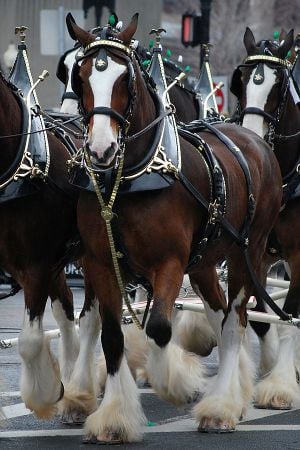
Muscular and heavy draft horses are known as "coldbloods," as they have been bred to be workhorses and carriage horses with calm temperaments. Draft horses originate mainly from northern Europe, and especially from Great Britain. Harnessing a horse to a carriage requires some level of trust in the horse to remain calm when restrained. The best known coldbloods would probably be the Budweiser Clydesdales, a breed that comes from Scotland.
"Warmblood" breeds began in much the same way as the thoroughbred. The best of their carriage or cavalry horses were bred to Arabian, Anglo-Arabian, and thoroughbred sires. The term "warmblood" is sometimes used to mean any draft/thoroughbred cross. Currently, the warmblood name has become the term to specifically refer to the sporthorse breed registries that began in Europe. These registries, or societies, such as the Hanoverian, Oldenburg, Trakkhener, and Holsteiner have dominated the Olympics and World Equestrian Games in Dressage (competitive horse training) and Show Jumping since the 1980s.
Tack and equipment
Tack refers to the equipment worn by the horse, normally when being ridden for exercise. The tack may be made from leather or a synthetic material. The basic tack a horse requires is:
- A bridle, including a bit and reins
- A saddle, including stirrup leathers, stirrups, and a girth
- A saddlecloth/pad
- A halter and lead rope
Horses in sport today
Horse racing
Horse racing has had ancient roots, as humans strived to know which horse (or horses) could move the fastest. This continues today. Thoroughbreds have a pre-eminent reputation as a racing breed, but Arabians, quarter horses, and Appaloosas also race on the flat in the United States. Quarter horses traditionally raced for a quarter mile, hence their name. Steeplechasing involves racing on a track where the horses also jump over obstacles. It occurs most commonly in the United Kingdom. Standardbred trotters and pacers race in harness with a sulky or racing bike. In France, they also race under saddle.
Several categories of racing exist today:
Races subject to formal gambling
- Thoroughbred flat racing
- Thoroughbred national hunt racing or steeplechasing (in the United Kingdom)
- Quarter horse racing (mostly in the United States)
- Appaloosa horse racing
- Arabian horse racing
- Harness racing
Amateur races without gambling
- Endurance riding. This sport, in which the Arabian horse dominates at the top level, has become very popular in the United States and in Europe. Endurance races take place over a given, measured distance and the horses have an even start. Races range from 20 miles to 100 miles in length.
- Ride and Tie. Ride and Tie involves three equal partners: two humans and one horse. The humans alternately run and ride.
Show Sports
The traditional competitions of Europe
The three following count as Olympic disciplines:
- Dressage. Dressage ("training" in French) involves the progressive training of the horse to a high level of impulsion, collection, and obedience. Competitive dressage has the goal of showing the horse carrying out, on request, the natural movements that it performs while running loose. One dressage master has defined it as "returning the freedom of the horse while carrying the rider."
- Show jumping. This competition comprises a timed event judged on the ability of the horse and rider to jump over a series of obstacles, in a given order, and with the fewest refusals or knockdowns of portions of the obstacles. At the Grand Prix horse racing level fences may reach a height of as much as 6 feet.
- Eventing, combined training, horse trials, "the military," or "the complete test." This puts together the obedience of dressage with the athletic ability of show jumping, the fitness demands of a long endurance phase, and the "cross-country" jumping phase. In the last-named, the horses jump over fixed obstacles, unlike show jumping, where the majority of the obstacles will fall down or apart if hit by the horse.
Found in the United States
- Huntseat. These judge the movement and the form of the horse over fences.
- Saddleseat. Saddleseat (also known as Park or English Pleasure riding) is a uniquely American discipline developed to show to best advantage the extravagantly animated movement of high-stepping gaited breeds such as the American Saddlebred and the Tennessee Walker. Riders also commonly show Arabians and Morgans saddleseat in the United States.
- Equitation. This refers to those classes where the position of the rider is judged rather than the form or movement of the horse.
Western riding
Dressage, jumping, and cross-country offer forms of what Americans refer to as “English riding” (although the United States has a strong following of riders in those disciplines). Western riding evolved stylistically from traditions brought to the Americas by the Spanish, and its skills stem from the working needs of the cowboy in the American West. A main differentiating factor comes from the need of the cowboy to rope cattle with a lariat (or lasso). The cowboy must control the horse with one hand and use the lariat with the other hand. That means that horses must learn to neck rein, that is, to respond to light pressure of the slack rein against the horse's neck. Once the cowboy has twirled the lariat and thrown its loop over a cow's head, he must snub the rope to the horn of his saddle. For roping calves, the horse learns to pull back against the calf, which falls to the ground, while the cowboy dismounts and ties the calf's feet together so that he can brand it, treat it for disease, and so on.
Among sport events in Western style are:
- Western pleasure. The horse must remain under control, with the rider directing through the reins and otherwise using minimal interference and show the horse in walk, jog (a slow, controlled trot), trot, and lope (a slow, controlled canter).
- Reining. Considered by some the "dressage" of the Western riding world, reining requires horse and rider to perform a precise pattern consisting of canter circles, rapid "spins" (a particularly athletic turn on the haunches), and the sliding stop (executed from a full gallop).
- Cutting. More than any other, this event highlights the "cow sense" prized in stock breeds such as the quarter horse. The horse and rider select and separate a calf out of a small group and leaves it entirely to the horse to keep the calf separated.
- Team penning. A popular timed event in which a team of 3 riders must select 3 to 5 marked steers out of a herd and drive them into a small pen. The catch: the riders cannot close the gate to the pen till they have corralled all the cattle inside.
- Trail class. The rider must maneuver the horse through an obstacle course in a ring; such maneuvers are relevant to everyday ranch or trail riding tasks.
- Barrel racing and pole bending. The timed speed/agility events of rodeo.
- Roping. In roping, the rider has to catch a running calf by the neck with a lasso, stop the animal in its tracks, rapidly dismount the horse and immobilize the calf by tying three of its legs together. In team roping, one horse and rider lassos a running steer's horns, while another horse and rider lassos the steer's two hind legs.
References
ISBN links support NWE through referral fees
- Siegal, Mordecai (ed.) 1996. Book of Horses: A Complete Medical Reference Guide for Horses and Foals. New York: Harper Collins. ISBN 978-0062701398
- Riegal, Ronald. 2003. Illustrated Atlas of Clinical Equine Anatomy and Common Disorders of the Horse. Equistar Publications. ISBN 978-0965446105
- International Commission on Zoological Nomenclature. 2003. Opinion 2027 (Case 3010). Usage of 17 specific names based on wild species that are pre-dated by or contemporary with those based on domestic animals (Lepidoptera, Osteichthyes, Mammalia). Bulletin of Zoological Nomenclature 60:81–84.
Credits
New World Encyclopedia writers and editors rewrote and completed the Wikipedia article in accordance with New World Encyclopedia standards. This article abides by terms of the Creative Commons CC-by-sa 3.0 License (CC-by-sa), which may be used and disseminated with proper attribution. Credit is due under the terms of this license that can reference both the New World Encyclopedia contributors and the selfless volunteer contributors of the Wikimedia Foundation. To cite this article click here for a list of acceptable citing formats.The history of earlier contributions by wikipedians is accessible to researchers here:
- Horse history
- Hyracotherium history
- American_Quarter_Horse history
The history of this article since it was imported to New World Encyclopedia:
- History of "Horse"
Note: Some restrictions may apply to use of individual images which are separately licensed.
↧ Download as ZWI file | Last modified: 02/04/2023 11:46:14 | 366 views
☰ Source: https://www.newworldencyclopedia.org/entry/Equus_caballus | License: CC BY-SA 3.0
 ZWI signed:
ZWI signed: KSF
KSF